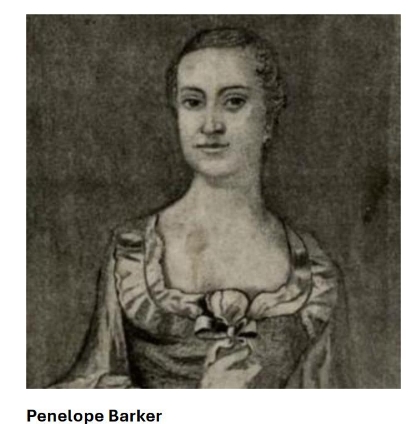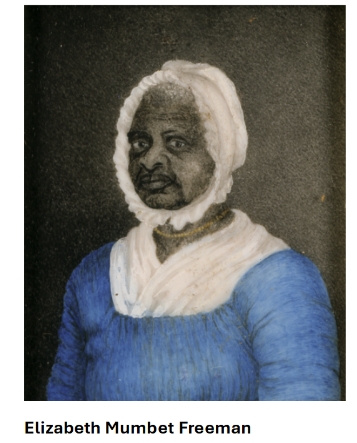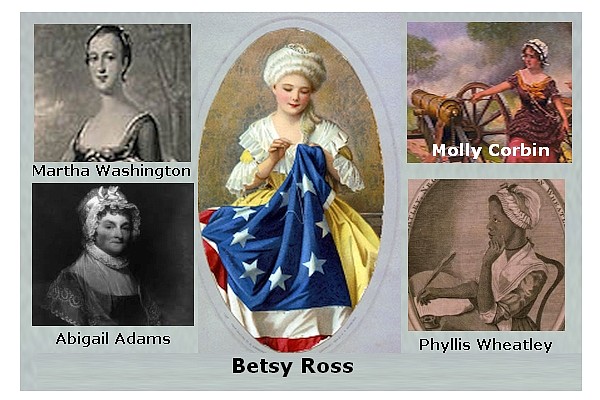March 23, 2024 at 12:58 p.m.
Matriarchs of the American Revolution
Compiled by Jennifer Baker, DAR Vesuvius Furnace Chapter
In honor of Women’s History Month, let us look at some of the women who are often overlooked when it comes to the American Revolution. So much of our history focuses on the men of the period, that it seems like one month is not enough time to think about all of the contributions by women that have been overlooked in our nation’s history.
Martha Dandridge Custis Washington was married to George Washington, the first President of the United States. Martha Washington was the first woman to hold the position of First Lady of the United States, even though the term “first lady” was not developed until after her passing. During her lifetime, she was frequently referred to as “Lady Washington,” which is how she became known to the public.
Abigail Adams was the wife of John Adams and the closest counselor to him. John would frequently consult Abigail for guidance on a variety of issues, and the correspondence between the two is full of insightful conversations on various aspects of government and politics. Her letters also provide as eyewitness reports of the fighting on the home front during the American Revolutionary War.
Margaret Cochran Corbin was the first woman to receive a military pension and was herself a military hero. On November 16, 1776, Corbin dressed as a man and joined her husband in the Battle of Fort Washington on Manhattan Island. There, she helped him load his cannon, and when he was killed, she quickly and heroically took over firing the cannon against the British. Other soldiers commented on “Captain Molly’s” steady aim and sure shot. Eventually, however, she, too, was hit by enemy fire, which nearly severed her left arm and severely wounded her jaw and left breast. She was unable to use her left arm for the rest of her life. The British eventually won this battle, with Corbin numbered among the prisoners of war who were paroled and released back to the care of Revolutionary hospitals. After she recovered, Corbin joined the Invalid Regiment at West Point, where she aided the wounded until she was formerly discharged in 1783. Then, on July 6, 1779, the Continental Congress, in recognition of her brave service, awarded her with a lifelong pension equivalent to half that of male combatants. Congress also gave her a suit of clothes to replace the ones ruined during the conflict. Corbin died near West Point before reaching her fiftieth birthday. In 1926, her remains were moved from an obscure grave along the Hudson River to West Point, where she was buried with full military honors.
Deborah Sampson Gannett was born on December 17, 1760, in Plympton, Massachusetts. She posed as a man, joined the Continental Army under the pretense of Robert Shirtliff, and participated in the fight for independence from Great Britain during the American Revolutionary War. She served for 17 months in the war before her gender was discovered in 1783, when she required medical attention for an illness she had contracted in Philadelphia. She had been serving in the army. After her true identity was revealed to her commanding officer at West Point, she was given an honorable discharge from the academy.
Elizabeth Grisom Ashburn Claypoole Ross (better know as Betsy Ross) was an American upholsterer who was credited by her relatives in 1870 with making the first official United States flag, which is why it is commonly referred to as the Betsy Ross flag. During the time of the American Revolution, Ross was responsible for making flags for the Pennsylvanian fleet. Following the American Revolution, she produced flags for the United States for more than half a century, including fifty garrison flags for the United States Arsenal on the Schuylkill River in 1811.
Phyllis Wheatley is widely recognized as the first African American woman to have a book of poetry published in the United States. She was stolen from her home in West Africa when she was around seven or eight years old, taken to North America, and eventually purchased by the Wheatley family of Boston. The people around her recognized her knack for writing poems when she started to read and write. Wheatley lauded King George III for vetoing the Stamp Act in 1768 in her poem “To the King’s Most Excellent Majesty.” Wheatley’s work took on a more revolutionary tone as the American Revolution gathered steam. Famous people like George Washington lauded her efforts.
Mary Ludwig Hays (also known as Molly Pitcher) was an American Revolutionary War soldier who lived from October 13, 1754, until her death on January 22, 1832. It has been documented that he served as artillery in the Continental Army during the 1778 Battle of Monmouth. Despite popular belief, other women on the battlefield that day contributed to the legend that became known as “Molly Pitcher.” Hays is often credited as the woman behind the Molly Pitcher mythology.
Nancy Morgan Hart grew up in the Yadkin River Valley, which was along the western frontier of the North Carolina colony. Nancy married Benjamin Hart around the year 1760. Nancy and Benjamin settled for a while in South Carolina, and by the time of the American Revolution, they were living along the Broad River in the colony of Georgia. Benjamin fought with the Georgia militia for the Patriots during the American Revolution. This meant that Nancy was solely responsible for keeping her family and their farm running. She must have struggled, because in 1781, the Georgia Executive Council voted to give the Hart family twenty bushels of corn to help them survive. In 1825, it was printed that, “One day a group of Loyalist soldiers came to her home and demanded a meal. Nancy welcomed them inside, set the table with food and drink, and once the soldiers relaxed, she took one of their muskets and held them hostage until her children could bring some neighboring Patriots to help her. The Loyalists were afraid to fight back, because Nancy was cross-eyed, and they could never tell exactly who she was aiming the musket at.” All the loyalists were supposedly hanged. For many years there was no proof and assumed a myth. When the railroad came through the land once owned by the Harts in the early 1900s, workers found skeletal remains of British soldiers with broken necks.
 Penelope Barker organized the famous Edenton Tea Party, the first recorded women’s political demonstration in America. Barker rallied 50 women in Edenton, North Carolina to sign a resolution boycotting British tea. The move was made in response to the 1773 Tea Act, passed by Parliament, which gave the British East India Tea Company a monopoly in the colonies and was the last in a series of taxes and policies that colonists fiercely resented.
Penelope Barker organized the famous Edenton Tea Party, the first recorded women’s political demonstration in America. Barker rallied 50 women in Edenton, North Carolina to sign a resolution boycotting British tea. The move was made in response to the 1773 Tea Act, passed by Parliament, which gave the British East India Tea Company a monopoly in the colonies and was the last in a series of taxes and policies that colonists fiercely resented.
 Elizabeth Mumbet Freeman was an enslaved woman whose court case set the legal precedent to abolish slavery in Massachusetts. The details of Elizabeth Freeman’s life are hazy. We know for a fact that she was a key player in one of the most important legal cases of the American Revolution. But Elizabeth never learned to read or write, so her life story was recorded by the people who knew her or historians who heard her story secondhand. This can make it difficult to know what motivated her, and how she felt about the events of her life. But sharing what we do know is important, because her choices changed the history of slavery in America.
Elizabeth Mumbet Freeman was an enslaved woman whose court case set the legal precedent to abolish slavery in Massachusetts. The details of Elizabeth Freeman’s life are hazy. We know for a fact that she was a key player in one of the most important legal cases of the American Revolution. But Elizabeth never learned to read or write, so her life story was recorded by the people who knew her or historians who heard her story secondhand. This can make it difficult to know what motivated her, and how she felt about the events of her life. But sharing what we do know is important, because her choices changed the history of slavery in America.
Sybil Ludington - On April 26, 1777, the daughter of a colonel in the colonial militia, Henry Ludington, is said to have made an all-night horseback ride of 40 miles (64 kilometers) to rally militia forces in neighboring towns in response to the burning of Danbury, Connecticut by British forces. She was only 16 years old at the time. Most are familiar with Paul Revere's 1775 ride, but hers was longer and more difficult. Sybil rode through the dark, in the woods and through the rain. Her ride was almost triple that of Revere.
Mercy Otis Warren was a prominent American poet, playwright, and pamphleteer during the Revolutionary War. She wrote poems and plays in the years leading up to the Revolution that criticized the monarchy in Massachusetts and called for Americans to fight back against British oppression. She wed fellow patriot and freedom activist James Warren. It was exceedingly unusual for a woman of her period to publish a collection of poetry and plays under her own name, but she did so in 1790. Her three-volume History of the Rise, Progress, and Termination of the American Revolution was published in 1805, making it one of the first works on the subject.
These 12 women are only a small representation of the thousands of contributions made by women throughout the colonies to support the American cause.





Comments:
You must login to comment.